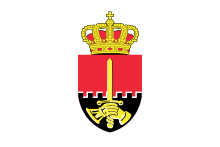Land Component
|
Land Component Composante terre / Landcomponent Landkomponente |
|
|---|---|

The flag of the Belgian army since 1982.
|
|
| Active | 1830–2002 (as the Belgian Army) 2002–present (as the Belgian Land Component) |
| Country |
|
| Allegiance |
|
| Type | Army |
| Size | 12,000 military personnel and 2,000 civilian personnel |
| Part of |
|
| Commanders | |
| Commander | Major-General Marc Thys |
The Land Component (Dutch: Landcomponent, French: Composante terre) is the land-based branch of the Belgian Armed Forces. The current chief of staff of the Land Component is Major-General Marc Thys.
For a detailed history of the Belgian Army from 1830 to post 1945 see Belgian Armed Forces.
Ranks in use by the Belgian Army are listed at Belgian military ranks.
According to the Law of 16 August 1873, the army was to consist of:
Note: a battalion (864 men) consists of four companies of 216 men
Note: a squadron had approximately 130 horses
Note: A battery has 6 guns
A major reorganisation of the army had been authorised by the government in 1912, providing for a total army of 350,000 men by 1926 - 150,000 in the field forces, 130,000 in fortress garrisons and 70,000 reserves and auxiliaries. At the outbreak of war this reorganisation was nowhere near complete and only 117,000 men could be mobilised for the field forces, with the other branches equally deficient.
The Commander-in-Chief was King Albert I, with Lieutenant-General Chevalier Antonin de Selliers de Moranville as the Chief of the General Staff from 25 May 1914 until 6 September 1914 when a Royal Decree abolished the function of Chief of Staff of the army. In this way the King secured his control of the command.
In addition, there were garrisons at Antwerp, Liège and Namur, each placed under the command of the local divisional commander.
Each division contained three mixed brigades (of two infantry regiments and one artillery regiment), one cavalry regiment, and one artillery regiment, as well as various support units. Each infantry regiment contained three battalions, with one regiment in each brigade having a machine-gun company of six guns. An artillery regiment had three batteries of four guns.
The nominal strength of a division varied from 25,500 to 32,000 all ranks, with a total strength of eighteen infantry battalions, a cavalry regiment, eighteen machine-guns, and forty-eight guns. Two divisions (the 2nd and 6th) each had an additional artillery regiment, for a total of sixty guns.
The Cavalry Division had two brigades of two regiments each, three horse artillery batteries, and a cyclist battalion, along with support units; it had a total strength of 4,500 all ranks with 12 guns, and was - in effect - little more than a reinforced brigade.
...
Wikipedia
